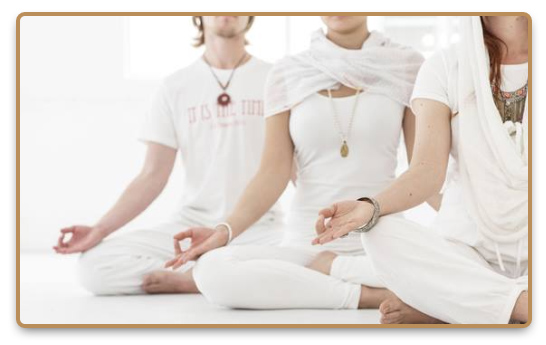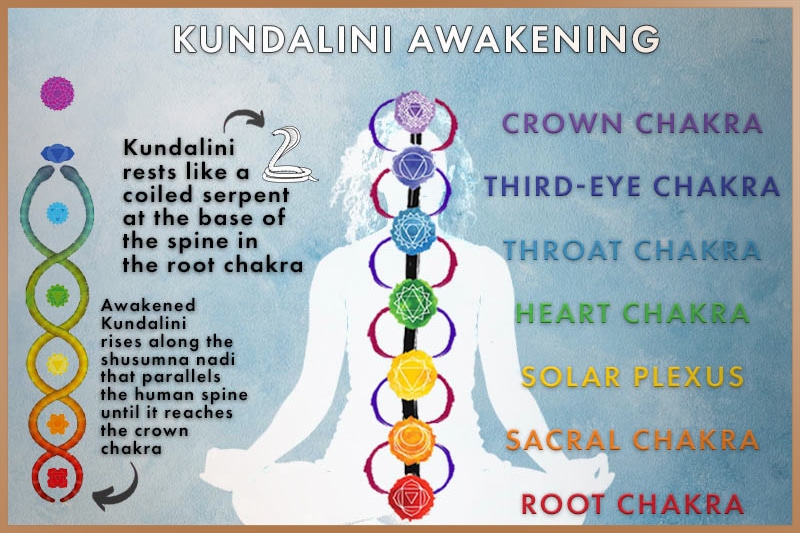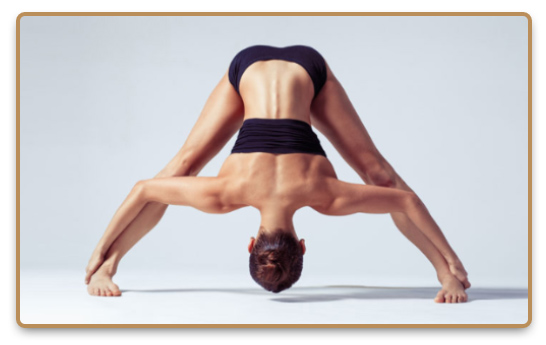
03 Feb Kundalini Yoga: How to Unleash Your Serpent Energy
What Is Kundalini Yoga?
Kundalini yoga is a practice developed to help unlock a latent energy that is said to be locked up in our lowest chakra, Muladhara, or root chakra, right at the base of our spine. This energy is known as kundalini or serpent energy and is often connected to our sexuality.
It is closely related to prana (some argue it’s just another form of prana) and is represented by the image of a snake wrapped around a lingam. The name itself means “coiled snake”. It is thought that through kundalini yoga, the power can be drawn up along the sushumna through the chakras. Once it reaches sahasrara, the chakra at the crown of our head, some feel they can reach smahi, a pleasurable state at which one finds their true self. Some even argue that this energy is the very root of our consciousness. It is a powerful, but possibly dangerous practice.
Although it may have origins stretching back further, kundalini yoga was first documented in the Indus Valley as far back as 3000 B.C.E. The modern practice of Kundalini yoga was brought to the West by the Sikh leader Yogi Bhajan in 1969 and has steadily gained popularity since.

It takes the same energy to complain as it does to compliment. When there is a short circuit, there is a complaint, and when the energy is flowing, there is a compliment.
What Does the Practice of Kundalini Yoga Look Like?
Kundalini yoga marries a number of different yoga practices including breathing exercises, meditation, mantras, mudras, and different asanas and kriyas with the ultimate goal of unleashing the kundalini energy laying dormant at the Muladhara and pulling it up through our sushumna to the sahasrara chakra to reach full benefits.

The Way to Kundalini Awakening
The key to opening up one’s kundalini energy is through pranayama, which is a method of pulling in energy through the act of controlled breathing.
The most powerful method of breath control is kumbhaka or breath retention exercises. There is a lot more to it than just holding one’s breath though. There is a specific amount of time one needs to dedicate to each step of inhalation, exhalation, and breath retention. One needs to train and practice to have the correct ratio.
See How to Practice Kundalini Yoga with a simple device.
This energy can be unleashed as well through special abdominal exercises such as through abdominal retractions, lifts, and recti isolations. First, one completely exhales their breath, then sucks in the abdominal muscles as hard as possible in a practice called Uddiyana Bandha. After some time and practice, one can start creating a wave motion with their abdominal muscles and isolate their recti abdominis, which lie along the sides of the abdominal wall.
A kriya is the combination of different asanas with breathing practices in sequence. Given that there is movement, these can be seen almost as a type of exercise and resembles much more closely to how many westerners view yoga.
Mudras are particular ways of holding one’s hands, as can be observed in depictions of the Buddha and the Hindi gods. It is believed that there is a direct link between the position of our fingers and how they are pressed together and our mind and body. Kundalini yoga uses a couple of mudras for different results. One is gyan mudra, which can encourage relaxation and help one open themselves to spiritual awakening. This is done by making a circle with one’s index finger and thumb, while keeping the other fingers of the hand together.

Kundalini yoga employs the use of mantras in its practice. They are either repeated syllables, phrases, or thoughts that are claimed to resonate certain energies within us through their vibrations. At their least mystical, mantras give people something to focus on during meditation. One of the most common mantras in Kundalini yoga is “sat nam”. It is taken from the ancient Gurmuhki language and can roughly be translated to “I am truth”. Sat nam has been described as a seed that grows into your true self. It can be chanted either during a sitting meditation or while walking.
During a seated meditation, the first syllable “sat” should be held while visualizing the energy pulling up from the base of the spine, then while holding the second syllable, one should visualize the energy surrounding them.
While walking one should say “sat” while stepping forward with the right foot and “nam” while stepping forward with the left.
It is suggested that one try to practice Kundalini yoga in a more spontaneous manner, specifically feeling which positions may be most beneficial for the individual practitioner instead of trying to fit a specific set of asanas. In many ways, the body will unleash this power when it’s ready. Forcing the release of the energy can either be ineffective or harmful.
What Are the Benefits and Risks of Kundalini Yoga?
Kundalini yoga is an intensive practice that utilizes many aspects of yoga and involves many years of dedicated practice to even reach a moderate level of its true benefits. This is not to say that one can’t find anything beneficial from only casual practice though.
Despite the significant benefits of Kundalini Yoga, it is not recommended that it be practiced carelessly or ignorantly. Yogis often criticize contemporary literature and yoga studios for oversimplifying or glamorizing the practice without appreciating its complexity and risks.
What Happens When Kundalini Awakens?
One of the most exalted benefits of Kundalini yoga is the unravelling of the serpent power in our spine and bringing this energy up through our chakras, with the ultimate goal of bringing it to sahasrara, the highest chakra at the crown of our head. When this happens, it is described as a very blissful state known as samadhi. When this happens, people are claimed to be able to let go of their ego and achieve their true self.
Once one reaches this point, they can move their consciousness through the different planes connected to each chakra. This is not something that happens to all practitioners. In fact, it is quite rare. Some yogi scholars believe that there are other, more effective ways to reach samadhi. Some even think that it is not enough in itself to reach this highest plane of consciousness, but that does not negate this yoga’s power.
Some people may be unable to handle this level of spiritual awakening, and thus it can be dangerous in some cases. It is recommended that kundalini yoga should be done only with the guidance of a master.
Kundalini Yoga requires strong mental, emotional, and physical preparation; attempting to awaken the Kundalini energy without proper instruction and preparation can cause mental and physical difficulties. Yoga is taught in various forms according to the circumstances of each student. Intense ascetic practices are not recommended for people in a family environment, as they require a level of discipline that may interfere with daily life. All forms of yoga, including Kundalini, should be practiced according to the individual’s ability and lifestyle.
Start practicing today
The Egely Wheel is trusted by thousands of people who practice yoga, telekinesis, meditation and healing. This device is the best solution for measuring your energy flow and efficiency of healing, and you get instant feedback.
Awakening this power is thought to be very transformative in one’s life. It can fill the practitioner with a feeling of connectedness to the universe and a general feeling of being energetic. If done in a methodical and careful manner, the energy can cleanse the body of toxins, break up blockages in our energy channels, and give purification of our spiritual and physical selves.
This is not always a pleasurable experience. It has been described sometimes as being like a bad drug trip. Some warn that when one starts to unlock the energy, they can feel headaches, itchy feelings, stomach issues, dizziness, sleep disturbances, and general discomfort. These feelings often go away and many claim that the ultimate results outweigh the initial unpleasantness.
Done correctly, Kundalini Yoga can lead to remarkable experiences and is not inherently bad. Its goal is to enable people to transcend their limitations and live life to the fullest. Everyone seeks to enhance their life experiences in their own unique way (through singing, dancing, and other activities), but Kundalini Yoga provides a methodical, empirical solution to this universal longing.
Breath Control in Kundalini Yoga Can be Harmful
Breath control is not always a safe practice. Extreme use of breath control can be harmful to one’s health, so it is encouraged to only practice with the help of an experienced yogi. Even so, it is a very difficult practice.
In addition to the energy goals, the aforementioned abdominal exercises can also strengthen the abs, increase libido, improve digestion and metabolism, and massage the internal organs such as the liver, kidney, pancreas, and spleen. Numerous studies have shown that practising yoga in general is an extremely beneficial form of exercise.
Will Kundalini Awakening Bring Magical Powers?
There have been old texts from the sub-continent that claim this energy is connected to certain magical powers. These days, people are a bit more sceptical about these boasts. It could be that these were just listed as either exaggerations or attempts to create a positive PR for this practice.
Still, most yogis say that using the development of these abilities as a goal for kundalini yoga is either pointless or harmful for the true goal of self-realization. Also, this power can be either abused or misused.
Since perception is the only thing that gives us a complete picture of the universe, the goal of yoga practice is to enhance perception. Shiva holding a snake symbolizes the highest states of energy that result in the opening of the “third eye,” a metaphor for a level of consciousness that transcends the senses. The “third eye” is a metaphor for an inner, intuitive seeing rather than a real, physical feature. It has to do with seeing aspects of reality that are not visible to the naked eye. When the third eye “opens,” it can indicate the awakening of spiritual awareness and higher understanding.
Sexual Energy Can be Improved and Released With Kundalini Yoga
Because of its connection to the root chakra, it claimed that this energy has a direct connection to our sexual energy and libido. Therefore, the practice may help one channel this energy into a tantric or sexual practice for the purpose of achieving pleasure. It is also claimed that it can improve relationships by increasing the intimacy between partners.
Kundalini Yoga to Break Bad Habits
Specifically, by practising a specific series of intense abdominal exercises, one can potentially bring energy to their third chakra, which is the center of our willpower. It can cause a decrease in negative thought and procrastination, especially if one is able to maintain the practice regularly over time. Naturally, it’s only intuitive that replacing time consuming bad habits with a healthy exercise routine will be beneficial.
Some researchers have even explored the connection between this type of yoga and treating addictions to some success, however, further exploration is needed. In addition, it can bring people out of their comfort zones. Through this it has been thought to spark creative inspiration.
Kundalini Yoga for Detoxification
It has been claimed that it can help one detoxify after overeating, namely by raising our blood circulation, increased breathing and sweating, and encouraging digestion. However, many forms of exercise have similar benefits. This is not to say it can’t work.
Calming Effect of Kundalini Yoga
Different forms of meditation have been found to have a calming effect on most people. In general, any practice that has the effect of lowering cortisol levels in the body is thought to have a positive effect on one’s health. No matter what one’s opinion on the spiritual implication of this type of yoga practice, one cannot deny that any exercise or meditation routine would be overall beneficial.
Updated: July 27, 2024. – This article was originally published on February 3, 2021.
Discover more types of Yoga
-
Ashtanga Yoga: The 8 Limbs of Yoga Explained
Ashtanga yoga is a yoga practice developed by K. Pattabhi Jois and has grown to be one of the most popular styles with numerous offshoots. Learn more...
-
Bikram Yoga: The Hot Yoga Revolution
Bikram yoga is a style of hot yoga focusing on a core of 26 asanas. Due to the exploits of founder Choudhury Bikram, it has been surrounded in controversy. Learn more...
-
Hatha Yoga: Where It Started and What It Means
Hatha yoga is a catch-all term for many forms of yoga, but specifically refers to a varied traditional form practiced for hundreds of years. Learn more...




